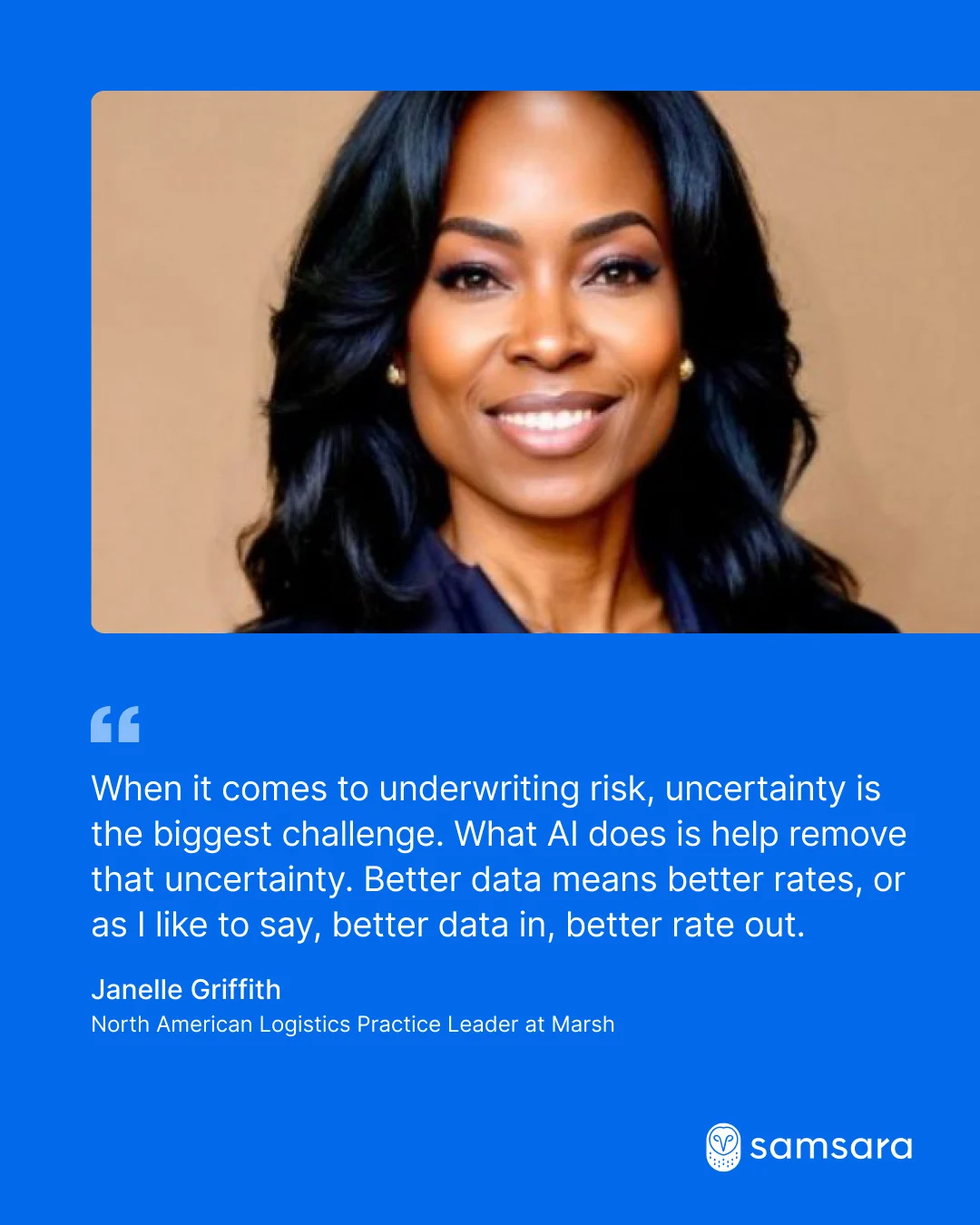Perspectives
Ready for the rush: How AI helps organizations navigate peak logistics season with confidence
November 13, 2025
Sr. Director, CEO & Executive Communications

Get the latest from Samsara
Subscribe nowEvery year, as the holiday rush approaches, companies in logistics, retail, and manufacturing brace for the same familiar pressures: labor shortages, extreme weather, rising theft, and surging customer demand. But what’s changing fast is how operations leaders are using artificial intelligence (AI) to turn those seasonal pressures into opportunities for lasting resilience.
I recently had the opportunity to sit down with four leaders on the frontlines of this transformation:
Tehzin Chadwick, Senior Vice President of Safety at UNFI, who leads one of the largest food distribution networks in North America.
Janelle Griffith, North American Logistics Practice Leader at Marsh, a global insurance broker and risk advisory firm, where she advises clients on risk and insurance strategy.
Dr. Ilya Jackson, Research Scientist at MIT, specializing in AI and supply chain optimization.
Sanjit Biswas, CEO and co-founder of Samsara, the platform powering connected operations across industries.
Together, we explored how AI is reshaping workforce management, safety, risk mitigation, and operational resilience. Here are the top takeaways that highlight how AI is helping companies not just survive the holiday rush, but build more sustainable and human-centered operations all year long.
1. Supporting the workforce and combating labor shortages during peak demand
Labor shortages and high turnover continue to challenge the logistics and transportation industries, particularly during peak seasons. However, AI is helping companies take a more strategic, data-driven approach to hiring, retention, and the employee experience.
At UNFI, Tehzin Chadwick described how the company has moved beyond short-term hiring spikes to focus on long-term workforce agility. “We’re not facing those same seasonal hiring pressures as in previous years,” she said. “This shift has allowed us to rethink how we approach workforce agility by focusing on building a stable, cross-trained team that can flex with changing business demands.”

Chadwick explained that AI now plays a critical role in helping employees grow once they’re in the door. “AI helps us personalize onboarding, recommend learning pathways, and accelerate skill building,” she said. “That creates a real sense of opportunity and belonging—not just during the holiday rush, but throughout the year.”
For technology providers like Samsara, this data-driven approach is changing how companies structure their operations. “We’re seeing fleets use telematics data to replan routes so drivers can return home nightly,” said Sanjit Biswas. “That small change makes a huge difference in driver sentiment and retention. In environments where labor is so tight that kind of operational empathy pays off.”
2. Protecting frontline workers from extreme weather
As extreme weather events become more common, safety leaders are increasingly turning to AI to help predict, prevent, and respond to risk in real time.
Dr. Ilya Jackson of MIT framed the challenge succinctly: “As DOT data shows, one in five crashes happens on icy roads. Safety and extreme weather conditions are among the most critical challenges the industry faces—especially during major holiday disruptions.”
At UNFI, that risk has prompted a significant investment in integrated data systems. “We’ve upgraded our weather monitoring tools so real-time alerts are now built directly into our vehicle telematics system,” said Chadwick. “Dispatchers and supervisors can see a live fleet map with overlays for rain, snow, wind, and temperature, while drivers receive in-cab alerts about hazardous conditions. It’s truly a game changer.”

AI is also helping fleets address fatigue, one of the most persistent safety challenges. “Roughly half of all fatal accidents happen at night,” said Biswas. “AI can now analyze massive amounts of data to identify subtle, personalized fatigue patterns and alert drivers before incidents occur. That’s something we couldn’t do even a few years ago.”
3. Combating cargo theft and lowering risk exposure
While safety on the road remains paramount, another growing threat is happening behind the scenes: cargo theft. According to Janelle Griffith of Marsh, this issue has become “endemic” across the U.S. supply chain. “The results of tech-enabled cargo theft are now trending upwards of $35 billion annually,” she said. “Most of these thefts are no longer opportunistic—they’re planned, orchestrated, and often carried out by coordinated, tech-savvy rings.”

For insurers and risk managers, AI plays a critical role in reducing uncertainty. “When it comes to underwriting risk, uncertainty is the biggest challenge,” said Griffith. “What AI does is help remove that uncertainty. Better data means better rates, or as I like to say, better data in, better rate out.”
Biswas explained how the same AI techniques used to detect fraud in finance are now being applied to supply chains. “If a trailer starts moving at 2 a.m. on a Sunday and that’s unusual, AI can flag it instantly,” he said. “That’s how companies are catching sophisticated theft rings before major losses occur.”
He added that new hardware like industrial-grade Bluetooth trackers is further closing visibility gaps. “Customers are tagging trailers, pallets, even high-value equipment,” Biswas said. “That real-time data replaces what used to be a pen-and-paper process, and that’s a massive leap forward.”
4. Demonstrating the clear ROI of AI
Beyond safety and security, the financial benefits of AI are equally compelling. Across every industry represented on the panel, leaders pointed to quantifiable ROI from operational efficiency, cost savings, and reduced risk exposure.

Dr. Jackson shared MIT research showing that “integration of AI and machine learning can improve forecasting accuracy by 11% and reduce inventory costs by 15%.” As he put it, “In supply chain management, everything depends on accurate forecasts, and AI is making those forecasts dramatically better.”
At UNFI, Chadwick sees those benefits play out daily. “AI tools help us position inventory more accurately, reduce congestion in our warehouses, and improve service levels,” she said. “The ROI is clear: better service, lower costs, higher productivity, and most importantly, a safer, more sustainable workplace.”
That balance between technology and trust is something Biswas sees across Samsara’s customer base. “We’ve analyzed data across thousands of fleets and found that after six months, crash rates drop an average of 37%,” he said. “For long-term adopters, that number climbs as high as 73%. And with AI automating things like driver coaching and data insights, it’s helping smaller fleets avoid overload and focus on what matters most.”
The real promise of AI: Smarter decisions, resilient teams
From workforce retention to risk management, from safety to ROI, one message from our conversation was unmistakable: AI is no longer theoretical—it’s practical, measurable, and transformative.
As Biswas put it, “This isn’t about replacing people—it’s about giving them the tools and insights to make faster, smarter, and safer decisions. That’s how we build more resilient operations for everyone.”
Get the latest from Samsara
Subscribe now

















